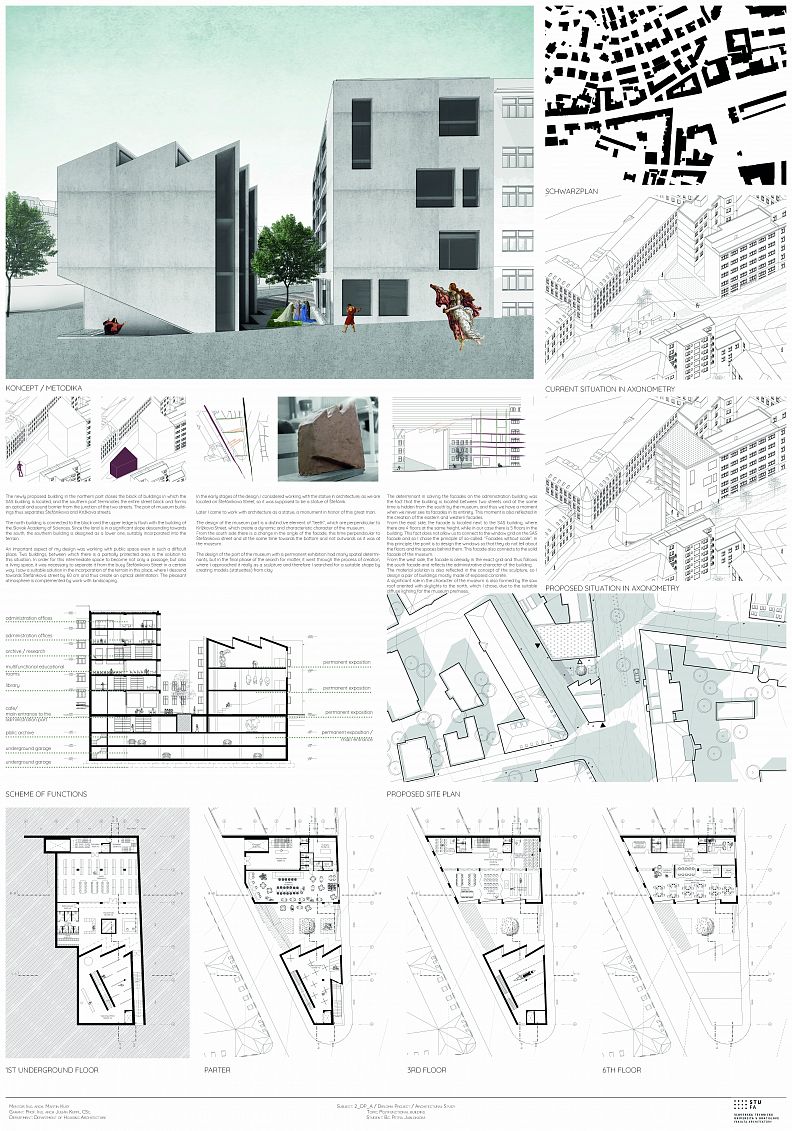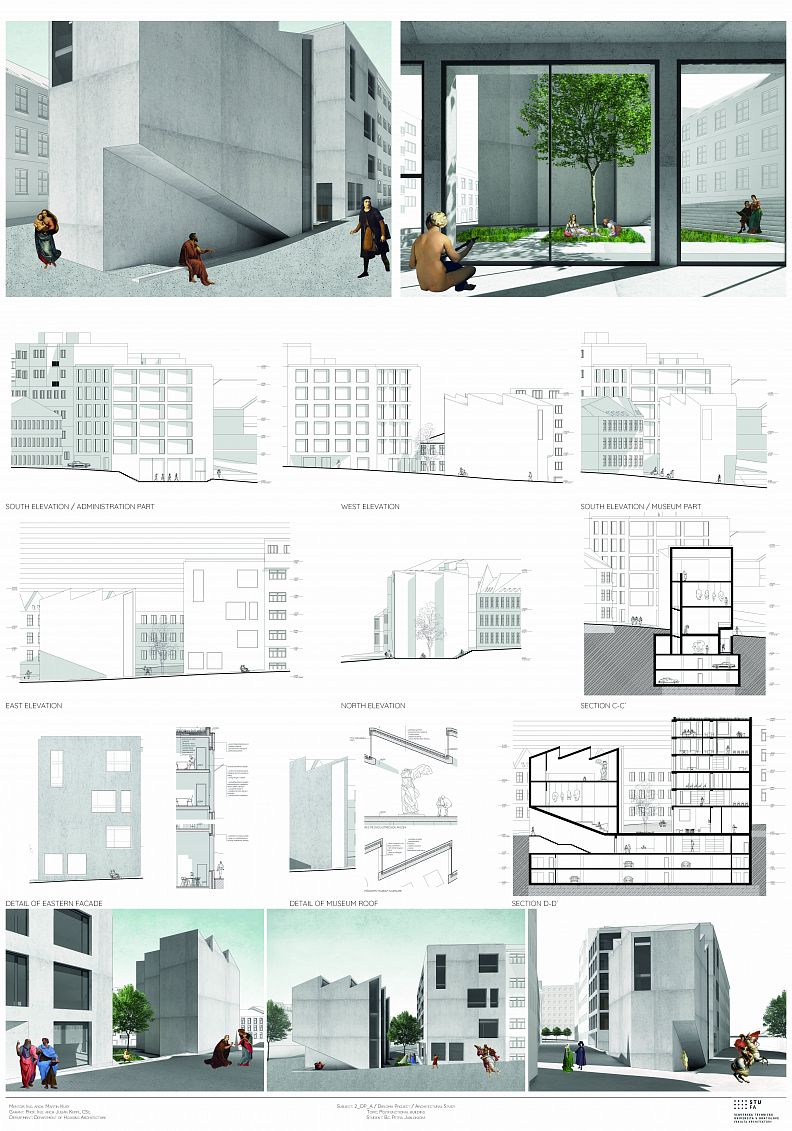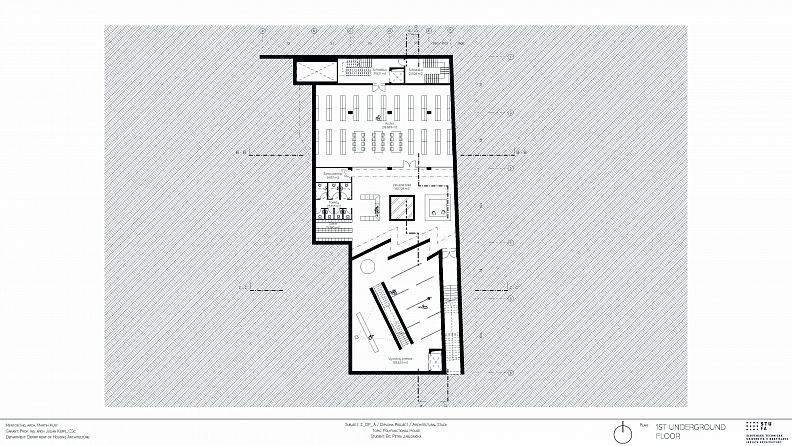Documentation Centre of Democracy in Bratislava, Slovakia

Project idea
INTRODUCTION
The topic of solving the completion of a block of buildings with the Slovak Academy of Sciences directly affects me, as I go through this part of the city every day. I perceive this land at different time horizons and therefore I see different problems that are taking place here. Whether it's a busy main road on Štefánikova Street, a dead space near the city center, or a noticeable discomfort in the evening.
I set myself the goal of eliminating these unfavorable moments and, even in this, at first glance difficult place, creating an environment that encourages people to stay and a pleasant atmosphere.
Another challenge in my proposal was to assign a function to the proposed object, which would not only have a practical use, but to have a certain higher symbolic and educational value for society.
URBAN BACKGROUND
We are located in the Old Town of Bratislava, near the historic center on Štefánikova Street, which is one of the few streets in Bratislava with a continuous historical development. Although this street is one of the oldest streets in Bratislava, it is marked by the scar of a busy four-lane road stretching across the Old Town, crossing the SNP bridge.
The terrain in this area rises significantly from two sides to the north and west. To the west, the terrain rises to the Slavín monument.
The land is surrounded not only by the busy Štefánikova street, but also by the smaller Krížková street, which at the end point connects with Štefániková. However, another road connecting these two streets from the direction of Patrónka passes through the solved area. There is also a public transport stop from the eastern part of the plot.
All these aspects leave us at a critical point at the junction of two streets at their immediate interface and form the land in the shape of a triangle cut by another road.
When analyzing the area, it was found that the road lanes on Štefánikova Street are up to 4 m wide, which together with its character of a four-lane road creates a feeling of freedom for drivers and thus encourages them to drive fast.
The first step of the design was to narrow the lanes to 3 m, move the branch road from the direction of Patrónek lower, to the level of the connection with Krížková street and also transfer the stop under this connection, south to Štefánikova street.
These changes in roads allowed us to expand the land to the same level as the buildings of the SAS block and at the same time release it to the entire area without further scars.
The urban solution is based on the analysis of the surrounding buildings, where we see that we are located between the block of flats in the east and the point-out of town houses to the west. From the analysis of the green areas, we can see that there is a semi-public garden in almost every courtyard.
URBAN CONCEPT
The newly proposed building in the northern part closes the block of buildings in which the SAS building is located, and the southern part terminates the entire street block and forms an optical and sound barrier from the junction of the two streets. The pair of museum buildings thus separates Štefánikova and Krížkova streets.
The north building is connected to the block and the upper ledge is flush with the building of the Slovak Academy of Sciences. Since the land is in a significant slope descending towards the south, the southern building is designed as a lower one, suitably incorporated into the terrain.
Project description
ARCHITECTURAL SOLUTION
In the early stages of the design, I considered working with the statue in architecture, as we are located on Štefánikova Street, so it was supposed to be a statue of Štefánik. Later I came to work with architecture as a statue, a monument in honor of this great man.
In the architectural solution, emphasis is placed mainly on the aspect of the collision of two streets, when it is necessary to work with two characters of the street line, space and atmosphere, which we want to evoke. Two streets mean two planes that I work with in my design.
The design of the museum part is a distinctive element of "teeth", which are perpendicular to Krížkova Street, which create a dynamic and characteristic character of the museum. In each promontory there is a window from the east side, which is not immediately visible when entering the space and therefore does not interfere with the experience of the exhibition, but when the visitor walks up to it, he has a view of the square and the street. The mass on the east façade gives way to the staircase, which is the forecourt of the main entrance to the museum, which is situated on the first underground floor.
A significant role in the character of the museum is also formed by the saw roof oriented with skylights to the north, which I chose, due to the suitable diffuse lighting for the museum premises.
The only window in the south facade is situated on the highest (third) floor, where the visitor is offered a view of the green Štefánikova Street.
The design of this part of the museum had many spatial determinants, but in the final phase of the search for matter, it went through the process of crea-tion, where I really approached it as a sculpture and therefore I searched for a suitable shape by creating models (statuettes) from clay.
The northern building of the museum is mainly an administrative part of the complex, but there are also supporting public functions that are part of the documentation center.
From the architectural point of view of the administrative part of the museum, it is a simple shape that naturally complements the block of buildings. Only in the level of the facades does the solution come in more diverse.
From the south side, the facade is designed in a similar way as the museum building, but since it is a different character of the building, a more moder-ate architectural expression is chosen. The change is in the angle of the fa-cade, this time perpendicular to Štefánikova Street and at the same time to-wards the interior and not outwards as it was at the museum.
The determinant in solving the facades on the administration building was the fact that the building is located between two streets and at the same time is hidden from the south by the museum, and thus we have a moment when we never see its facades in its entirety. This moment is also reflected in the creation of the eastern and western facades.
From the east side, the facade is located next to the SAS building, where there are 4 floors at the same height, while in our case there are 5 floors in the building. This fact does not allow us to connect to the window grid on the SAS facade and so I chose the so-called "Facades without scale". In this prin-ciple, the point is to design the windows so that they do not tell about the floors and the spaces behind them. This facade also connects to the solid fa-cade of the museum.
From the west side, the facade is already in the exact grid and thus follows the south facade and reflects the administrative character of the building.
The material solution is also reflected in the concept of the sculpture, so I design twe pair of buildings mostly made of exposed concrete.
DISPOSITIONAL SOLUTION
Since the museum consists of two buildings, I was looking for a solution to solve the common main entrance. The only option was to enter the first underground floor. Although it is mainly the main entrance to the part with a permanent exposition, in the northern part of the floor there is a public archive, from which it is possible to go to the first floor in the place of the administrative building.
The visitor enters the museum in the underground part, which is illuminated by skylights from the square. There is an entrance hall, toilets and changing rooms for visitors, but part of the exhibition is already starting here. The other three floors are also dedicated to the permanent exhibition. It is possible to get out of the underground car park by an elevator, which is also designed to be expensive for this building. The barrier-free entrance is solved from the northern building, where the visitor goes to the first underground floor and to the main hall.
The building in the north of the plot is designed for the secondary functions of the museum. The ground floor of the building is oriented to the newly designed square and thus has a lively urban character. There is a café facing the side of the square. There is an entrance to Krížková Street for employees, but also for visitors to the library or events held in these spaces. Next to the entrance there is also an elevator to the underground garages.
The second and third floors are publicly accessible to visitors, so there is a library on the second floor and the third floor is designed for multifunctional use with variable partitions where various screenings, workshops, circles or conferences can take place.
The fourth floor is focused on research and an additional archive inaccessible to the public.
The fifth and sixth floors are intended only for employees of the documentation center, where their open office spaces are located. Alternatively, it is possible to lease one floor of the administration to external organizations or researchers from the Slovak Academy of Sciences.
Technical information
From a structural point of view, the museum consists of two separate structural units connected by three underground floors. The construction system is solved in both units as a combined column wall-system. The irregular shape of the plot also required a special solution in the area of the supporting structure. The three underground floors are partly situated under a public road. The third and second underground floors are designed as underground car parks accessible by an elevator from Krížková Street, with a majority modular system 5.5 x 7.8 m. The first underground floor is designed as an entrance floor with an entrance hall below the square, where the module is extended to 10.4 m, which is also the width of the square.
The administration building is then solved in a module 5.5 x 7.8 m, with a construction height on the ground floor of 5.5 m due to the connection to the surrounding buildings and landscaping. The remaining 5 floors have a construction height of 3.4 m.
The museum building has one underground floor and three overground floors, with a clear height on the ground floor of 5.5 m and in the remaining two floors 4.3 m, as these are exhibition spaces that need flexible spatial solutions. The load-bearing system is a combined column-wall system based on the module from the garages, where the concept of the museum space was taken into account when determining the module. The roof above the museum is designed as a self-supporting shed roof with three sections, in which skylights oriented to the north side are located.
The material used for the entire construction is concrete. I use not only its visual side on the facade, which supports the concept of the sculpture, but also its structural properties and is therefore used for the entire load-bearing structure.
Co-authors
mentor: Ing.arch. Martin Kusy


































